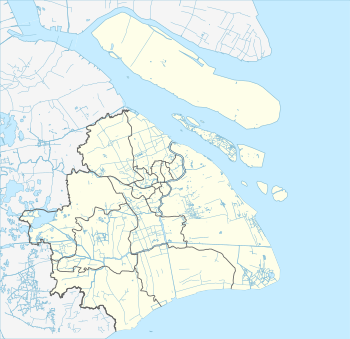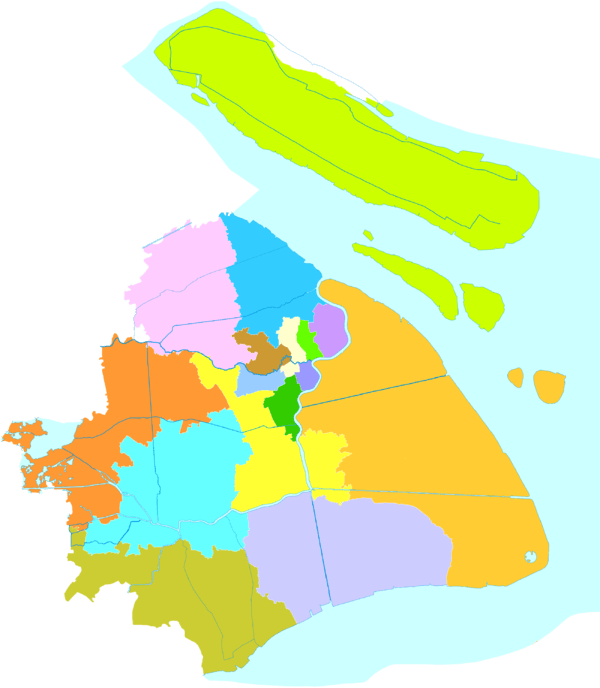Shanghai South railway station
Shanghai South station (Chinese: 上海南站; pinyin: Shànghǎi Nánzhàn; Shanghainese: Zånhae Nuezae), is a railway station in the city of Shanghai, China. Located in the Xuhui District, its importance is second only to the Shanghai railway station. After extensive renovation that was finished in 2006, the station features a modern circular design, the first of its kind in the world. The station was expected to handle 15 million passengers annually.[1]
 Shanghai South (Shanghainan) railway station | |||||||||||||||
| Other names | Shanghai South | ||||||||||||||
| Location | Laohumin Lu, Xuhui District, Shanghai China | ||||||||||||||
| Coordinates | 31°09′16″N 121°25′27″E | ||||||||||||||
| Operated by | Shanghai Railway Bureau | ||||||||||||||
| Line(s) |
| ||||||||||||||
| Platforms | 11 (5 island platforms, 1 side platform) | ||||||||||||||
| Connections |
| ||||||||||||||
| History | |||||||||||||||
| Opened | 1908 (former address) 2006 (current address) | ||||||||||||||
| Closed | 1937 (bombed by the Japanese) | ||||||||||||||
| Services | |||||||||||||||
| |||||||||||||||
| Location | |||||||||||||||
 Shanghainan Location in Shanghai | |||||||||||||||
Shanghai South serves most trains to cities of Zhejiang (including Hangzhou, Shaoxing, Ningbo, Jinhua and Wenzhou) and the Southern provinces of China, excluding the Shanghai-Hong Kong Route. Without a Customs/Immigration checkpoint it is not capable of clearing passengers straight to Hong Kong; until such a checkpoint is constructed the Shanghai–Kowloon through train will continue to depart from Shanghai station. It is also possible to catch high-speed services to West Kowloon station in Hong Kong via Shanghai Hongqiao railway station: - customs and immigration clearance is done in Hong Kong.[2]
Shanghai South railway station also serves as the starting point for the Jinshan railway, running via Xinzhuang in Minhang District to Jinshanwei in Jinshan District, crossing the Huangpu River on a dedicated railway bridge.[3]
History
Shanghai South station was originally constructed in 1908 as the terminus of the Shanghai-Hangzhou railway line. In 1937 during the Battle of Shanghai, part of the Second Sino-Japanese War, the Japanese advanced towards the station in an action known as Bloody Saturday. The fighting destroyed the building and killed many civilians; a photograph showing a crying Chinese baby among the ruins became Time's image of the year.[4][5][6]
An extensive redesign has been carried out until 2006 by AREP (Paris), ECADI (Shanghai) and MaP3 (structural engineer - Paris), making the new station the world's first circular railway station. With the reopening, two minor Shanghai railway stations have been closed: Shanghai West in Putuo District and Meilong station near Jinjiang Park. All railway connections of these stations have been moved to Shanghai South station, and according to estimates, up to 40% of passengers of Shanghai station will be diverted to the new station.
A station fire occurred on April 24, 2010 at 4 pm that was extinguished in 30 minutes.[7]
Station
The Station is located in the southwestern part of Xuhui District, occupying sixty hectares of land. Contrary to most Chinese railway stations, the new look of South Station has a very clean, airport-like look and feel. The station itself is elevated 47 meters above ground and has a diameter of some 270 meters. It is made out of polycarbonate and aluminium sunblades, and supported by 18 branch-shaped beams resting on 3 columns each. The steel structure weight is 6000 T, for 56 000 square meters, and a 150 m maximum span. The steel structure was built by Shanghai Jiangnan shipyard and erected by SMCC.
The trains arrive below the waiting areas, which are not interrupted by the structure itself, which is roughly divided into three levels. The mid-level contains the station platforms, at the same rough height as ground level, and contains thirteen tracks and six passenger platforms. The VIP waiting section and the Public Security Office is also on this level. In addition the mid-level has direct access to the northern and southern squares. The upper level is the departure level. With a circumference of over 800 meters, the waiting area can fit over 10,000 passengers at any given time. Passenger tickets are also validated in this area. The lower level is the arrivals level, which contains various tunnels to exit the station and the waiting area of the Line 1 and Line 3 in the Shanghai Metro system. In the future it will also contain a transfer tunnel to the newly opened L1 Line as well as access to long-distance and tourist buses. The underground level of the North and South Squares has various commercial establishments and a parking lot.
The soft-seat waiting area requires a soft-class train ticket to access. The seating in the area is generally more comfortable, and it is an enclosed area, with security personnel on shift at the entrances. The regular waiting area is in the middle of the station, and can house thousands of passengers. The VIP waiting area is only accessible with special identification, such as diplomatic documents.
Shanghai South is serviced by Shanghai Metro Line 1 or Line 3 via the interchange station of the same name, which is within walking distance of the train station. Transfer corridors in the station building allow indoor transfer between the train station and the metro station.
See also
- Rapid transit in the People's Republic of China
- Shanghai, Shanghai North, Shanghai West, and Hongqiao railway stations
References
Citations
- "Landmark Shanghai South Railway Station Under Construction". Getty Images. 25 April 2005. Archived from the original on 24 September 2015. Retrieved 12 June 2015 – via HighBeam Research.
- https://www.highspeed.mtr.com.hk/res/pdf/long-haul-train-timetable-tc.pdf
- "Bullet train to suburbs starts by end of month". Jinshan District Government. September 18, 2012. Archived from the original on August 8, 2014. Retrieved 2012-09-20.
- Doherty, Thomas (1999). Projections of war: Hollywood, American culture, and World War II (2 ed.). Columbia University Press. p. 105. ISBN 0-231-11635-7.
- Van der Veen, Maurits (2003). Uriel's Legacy. Trafford Publishing. p. 262. ISBN 1-55395-462-9.
- Cameron, Mrs. Richard; Malcolm Rosholt (January 21, 1972). "Letters to the Editors: The Child". Life. Time, Inc. 72 (2): 27. ISSN 0024-3019.
- Yuan, Rong (April 24, 2010). 网友曝料称上海火车站冒出滚滚浓烟 (图) (in Chinese). xinmin.cn. Retrieved 25 April 2010.
External links
| Wikimedia Commons has media related to Shanghainan Railway Station. |
- Shanghai Train Guide - Timetables & Tips & Routes & Schedule

